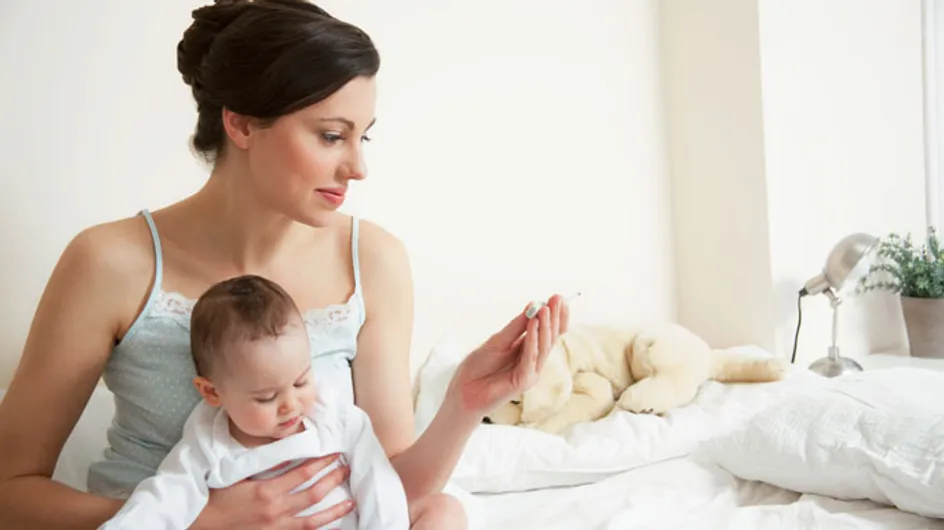It’s no wonder that a recent study for Nurofen for Children found that for 30 per cent of the 2000 mums asked, the first time their child had a fever was the most confusing and scary part of parenting.
But one thing that you should know first off, is that fever in babies is normally a sign that the body is fighting off an infection and rarely does it cause any harm.
Tinies Childcare Expert, Kristen Harding, says: “It’s hard not to worry and panic, but a fever is part of our normal defences and shows that the child’s immune system is working. Trust your instincts though, you are the expert on your child and know them the best.”
But one thing Dr. Pixie McKenna says to watch out for is if they’re “grizzly”, the stage between happy and howling the place down.
It might take a while for you to be able to spot it immediately, but that's a sure sign your baby is unwell.
How can you tell if your baby has a fever
There are a few different ways to tell if your baby has a fever. If they’re hot to the touch then usually something will be up. Other things to look out for are drowsiness, being difficult to settle, flushed or pale skin, being irritable and generally unlike their usual selves.
If you've done the touch test and think something is up then you can test their temperature with a variety of different thermometers, what you’re looking for is a temperature of over 37.5 C.
Kristen says: “A baby’s temperature can vary widely, as the temperature regulating part of the brain is still immature and not fully developed. But it’s normally thought that anything over 37.5 C should be classed as a fever.”
Digital thermometers are thought to be the best but you can also use strip foreheads and ear thermometers but the latter are thought to be less effective and more expensive.
What causes fever?
A high temperature can be caused by a lot of different things but it is usually a sign that the body is fighting infection or illness.
“Viruses are most probably the most common cause of a fever in a child but ear, throat and urinary tract infections can also be a cause. Teething, routine immunisations and the usual childhood illnesses such as measles, chicken pox, mumps etc. can all cause a rise in body temperature. Do also be aware that sometimes your baby could just be overdressed," says Kristen.
Is there anything you can do at home?
One piece of assurance is that normally there are plenty of things that you can do yourself to help calm your baby’s fever. Dr Pixie says: “Fever is like a toaster fire, not a towering inferno - you just need to put it out.”
So just keep calm, follow these next steps and everything will be under control.
This can be broken down into four easy to remember steps to keep your child’s fever controlled:
- Drink
- Down
- Dress
- Medicine
The most important thing you can do is make sure your baby is getting plenty of hydration. Kristen Harding recommends encouraging cool fluids as well as any normal breast or bottle-feeds.
“If they don’t want to eat that’s fine as long as they are drinking,” she says.
The next is to make sure your baby isn’t overheating. So this means turning down the heating in your house and removing any excess clothing.
“It’s quite acceptable for them to be just dressed in a nappy and a vest or just use a light sheet when sleeping. You could also use an electric fan to cool them down, ensuring it’s out of harm’s way,” says Kristen.
If this still hasn’t made a difference to your child’s temperature then give them something to keep it down. Dr. Pixie says that child’s Ibuprofen is just as acceptable (if not more so) than paracetamol, in fact it works quicker and lasts for longer.
“Follow the manufacturer’s guidelines and note the time you gave it, so you’re aware when they can have their next dose. Your child may feel sleepy so let them rest and check on them frequently during the night,” says Kristen.
Monitor their temperature regularly and remember lots of love and cuddles will always make a poorly child feel better too.
At what point should you go and see a doctor?
If your child is under three months old and has a temperature of above 37.5 C then you should consult your doctor immediately. However, once your child is older than three months old you should be able to bring down their temperature at home.
If your child does not improve, if they have had a fever for more than 5 days irrespective of their age, if they are particularly drowsy, difficult to rouse, not taking fluid or not wetting their nappies then go to the doctor straight away.
Keep an eye open for other worrying symptoms and focus on the way your child looks and feels, rather than what the thermometer is saying.
Worrying symptoms could include:
- A rash or mottled skin.
- High pitched cry
- Any signs of pain or headache
- Vomiting
- Inconsolable crying
- Neck stiffness
- Diarrhoea
Once you take your child to the doctor they will take the appropriate course of action to ensure a speedy recovery for your baby. Kristen says the most important thing during all of this, is for you to stay calm and trust your own ability to nurse your child.
“The first time your child has a fever it will be very frightening but do remember most are harmless and caused by mild infection. Trust your instincts, parents obviously know their children best and know when they are not well. If they develop any other worrying symptoms or give you any reason for concern, consult your doctor,” says Kristen.
If your gut tells you something is wrong, always have the confidence to follow it through and your baby will be back to bubbly in no time.
How did you deal with your baby's fever? Tweet us @sofeminineuk















